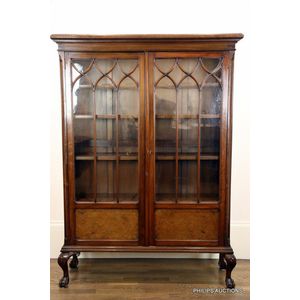Gothic Walnut Display Cabinet with Cabriole Legs
You must be a subscriber, and be logged in to view price and dealer details.
Subscribe Now to view actual auction price for this item
When you subscribe, you have the option of setting the currency in which to display prices to $Au, $US, $NZ or Stg.
- Cabriole Leg - The cabriole leg evolved from an elongated scroll, curving out at the knee which may or may not be carved, and forming a serpentine shape as it descends to the foot.
First introduced into English furniture in the late 17th century, cabriole legs were widely used during the Queen Anne and early Georgian periods, where they frequently terminated in a pad foot or ball and claw foot. The style has had many imitators since then. The cabriole leg was re-introduced in the mid-19th century, and is commonly associated with the balloon-back dining or drawing-room chairs made in walnut, mahogany or, in Australia, cedar. The Victorian cabriole leg, on the whole, was rather more slender than the earlier form, following the French style, which emphasized the delicacy and daintiness of the chairs they were designed to support. Cabriole legs are sometimes found on windsor chairs, especially those made during the 18th century. - Gothic Style, Furniture - Gothic style furniture refers to pieces that are designed and crafted in the Gothic architectural and decorative style that was popular in Europe from the 12th to the 16th centuries. This style of furniture is characterised by its elaborate and ornate details, as well as its use of dark and heavy woods, such as oak and walnut.
Gothic style furniture often features intricate carvings and embellishments, including pointed arches, quatrefoils, and tracery. The style also frequently incorporates elements such as coats of arms, shields, and religious symbols. Gothic furniture often has a heavy and substantial appearance, and the pieces are often finished with a dark stain to accentuate the detailed carving and embellishments.
The furniture items can be quite large and imposing, and they are often used as statement pieces in large rooms. Gothic furniture can be a striking and dramatic addition to any space, and it is often appreciated by those who have an interest in medieval and historical design.
This item has been included into following indexes:
- display cabinets, material - walnut and burr walnut 205
- display cabinets, period, age or style
Visually similar items

A French Louis XVI style kingwood vitrine, the yellow marble top above a marquetry decorated frieze, below a pair a glazed doors with panels of floral marquetry on short tapering legs with ormolu sabots. 150 cm high, 80 cm wide, 30 cm deep

A Continental walnut breakfront bibliotheque, with a rouge marble top above a moulded cornice, and four glazed doors enclosing adjustable shelves on turned tapering feet. 213 cm high, 184 cm wide, 34 cm deep

An Edwardian inlaid display cabinet, early 20th century, the Sheraton Revival cabinet with a dentil embellished cornice above a swagged frieze, an astragal glazed door and side panels and internal shelving, a bow front lower section with a marquetry decora

French mahogany Louis XVI style two door vitrine, approx 170 cm high, 110 cm wide
